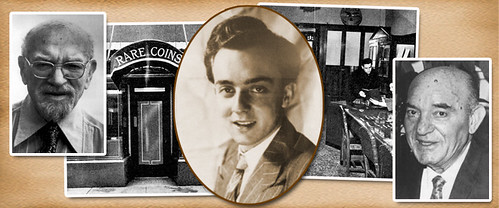
PREV ARTICLE
NEXT ARTICLE
FULL ISSUE
PREV FULL ISSUE
HARVEY STACK'S NUMISMATIC FAMILY, PART 15Harvey Stack's latest Stack's Bowers blog series focuses on growing up in a numismatic family. Here is part 15. -Editor
 • As noted before, in 1953 my uncle, J.B. Stack, traveled to Lawrence, Massachusetts to appraise an estate collection there. He made an offer and eventually received a call that his appraisal was accepted, and that our offer for the collection would be also accepted. J.B. was delighted. Since he did not drive and he and Morton were needed at the shop, I went to pick up the collection, which was to be the Davis Graves Collection. It had been stored in an abandoned weaving factory, watched over by a caretaker (I told of my packing and taking the collection back to New York in an earlier story). It consumed a portion of the funds we had reserved for purchases from the Farouk sale. However, it was a great collection, mainly large cents, but with numerous early colonial coins, not seen on the market for many decades. Because of the detailed cataloging it required, it could not be sold before the early part of 1954. In the late fall of 1953, my father and uncle met with an attorney about an estate in Connecticut. The collection had been assembled over 50 years, contained many premium coins, and was almost complete in a number of U.S. series. Because of the size and extent of the collection, my father, Morton, and Uncle J.B. traveled to the bank that stored the collection and they both examined it completely. They started at opposite ends of the conference table where the coins were laid out, examined the coins and wrote down a figure as to what should be paid for each group. A few hours later, they compared their notes and found that each had come up with virtually the same figure. The value was in the many hundreds of thousands of dollars and the two figures were separated only by $2,300. They checked each other's notes and found that on their way around the table, one did not include a small set that the other did. It was remarkable! They made an offer that was accepted by the banker and trust officer and this brought to New York the fabulous Anderson Dupont Collection of gold, silver and copper coins. Many early Proof coins were included in the collection and it also had a "hidden collection" that was left to the heirs of the company for eventual sale and that few ever saw. The purchase of the Anderson Dupont Collection consumed much of the remaining capital that had been set aside for the Farouk sale. However, as we always said in the family, "A bird in the hand was worth two in the bush." This was the way the firm built inventory, so when a client came in looking for something, it was in stock and available for sale. No matter whether it was a common Indian Head cent or a great rarity, if you didn't have it, you couldn't sell it. As my uncle and father were both involved with the chores they always had for the business: traveling, working in the shop or cataloging a collection, I was tasked with the daily work of keeping the office and store going. In addition, I traveled a bit, when a convention might be too long for my uncle, appraising and/or buying collections we were offered, or selling special items to clients. I was one of the first numismatists to be a member of the American Society of Appraisers and learned by working side by side with my uncle how to be a public auctioneer. The year 1953 was an important one for me and for Stack's. It also set the stage for important events in the years to come. To read the complete article, see: To read the earlier E-Sylum article, see: Many thanks to Harvey for recording his wonderful hobby remembrances - these are great reading, and will provide raw material for collectors and researchers of the future. -Editor
Harvey writes: This June, I will be 90 years old, and hope that the noggin keeps functioning, so I am glad that I have, and can, be able to recite things that happened way back then. My love of the hobby, and the people I encountered keeps me "young". I hope my experiences will be model for the current group of dealers, and that they can and will maintain the love and affection for the hobby, and give the best they can to make the hobby grow again, and realize that being a dealer is both an avocation as well as a vocation, and if you do it right by all, everyone will prosper while teaching others the glory and satisfaction of being a numismatist. I teased Harvey with the realization that he's actually older than sliced bread! -Editor
The first automatically sliced commercial loaves were produced on July 6, 1928, in Chillicothe, Missouri, using a machine invented by Otto Rohwedder... For more information on the birth of sliced bread, see: Harvey adds: For the record, I was born on June 3, 1928 and am still crusty !!!  Wayne Homren, Editor The Numismatic Bibliomania Society is a non-profit organization promoting numismatic literature. See our web site at coinbooks.org. To submit items for publication in The E-Sylum, write to the Editor at this address: whomren@gmail.com To subscribe go to: https://my.binhost.com/lists/listinfo/esylum All Rights Reserved. NBS Home Page Contact the NBS webmaster 
|